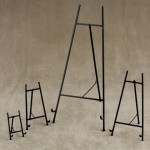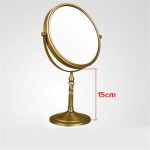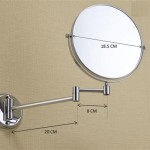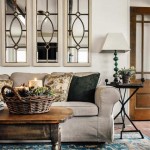The Alluring Elegance of Tall Narrow Antique Mirrors
Tall narrow antique mirrors offer a unique design element, capable of transforming spaces and adding historical charm to contemporary interiors. These mirrors, characterized by their elongated and slender profiles, provide both functional and aesthetic benefits. They are not merely reflective surfaces; they are historical artifacts, each possessing a story etched into their frames, glass, and overall construction.
The appeal of these mirrors lies in their ability to create the illusion of height, making them particularly effective in rooms with lower ceilings. Their vertical orientation draws the eye upwards, thereby expanding the perceived dimensions of the space. Furthermore, their antique nature introduces a sense of timeless elegance and sophistication, setting them apart from more modern, mass-produced alternatives.
The history of tall narrow mirrors is intertwined with the evolution of glassmaking and mirror production techniques. Early mirrors, often crafted using polished metal surfaces, were expensive and small. The advent of glass mirrors, particularly those backed with silver amalgam, revolutionized the industry, making mirrors more accessible and enabling the production of larger, more reflective surfaces. The desire for taller mirrors arose in alignment with changing architectural trends and the burgeoning demand for decorative elements within homes.
Antique mirrors, unlike their modern counterparts, frequently exhibit imperfections that contribute to their charm. These imperfections, such as slight distortions in the glass or subtle variations in the silvering, are testaments to their age and the traditional methods employed in their creation. They are reminders that these objects have existed for decades, perhaps even centuries, witnessing shifts in design preferences and societal norms.
Acquiring a tall narrow antique mirror requires careful consideration. Several factors contribute to the mirror's value and suitability for a specific space, including its age, condition, provenance, materials, and stylistic features. Understanding these elements ensures that the chosen mirror complements the existing décor and fulfils the desired aesthetic vision.
Determining Authenticity and Age
Assessing the authenticity and age of a tall narrow antique mirror necessitates a multi-faceted approach. Examining the glass itself can provide valuable clues. Older glass often contains subtle imperfections, such as bubbles or waves, resulting from the manufacturing processes of the time. Modern glass, in contrast, tends to be flatter and more uniform.
The mirror's backing is another crucial indicator. Historically, mirrors were backed with silver amalgam, a mixture of mercury and silver. Over time, this amalgam can degrade, resulting in dark spots or a hazy appearance. The presence of such deterioration is a strong indication of age. Modern mirrors typically use a different backing material, often aluminum, which is less susceptible to this type of degradation.
The frame of the mirror also warrants close inspection. The materials used, the style of carving, and the hardware employed can all provide insights into the mirror's period of origin. For example, a mirror with a hand-carved wooden frame featuring intricate details and dovetail joints is likely to be older than a mirror with a machine-made frame constructed with screws.
Examining the mirror's patina is also essential. Patina refers to the natural aging process that occurs on surfaces over time. On wooden frames, this may manifest as a subtle darkening or oxidation of the wood. On metal elements, such as hinges or decorative accents, patina may appear as a tarnish or discoloration. A consistent and authentic patina is a sign of age and authenticity.
Consulting with antique experts or appraisers can provide further confirmation of the mirror's authenticity and age. These professionals possess the knowledge and experience to identify subtle details and assess the overall condition of the mirror. They can also provide insights into the mirror's provenance, tracing its history and ownership.
Considering Style and Materials
Tall narrow antique mirrors are available in a wide range of styles and materials, reflecting the diverse design trends that have prevailed throughout history. Understanding these stylistic variations enables one to select a mirror that seamlessly integrates into a specific interior design scheme.
Mirrors from the Victorian era, for example, often feature ornate frames adorned with elaborate carvings, gilding, and decorative elements such as floral motifs or scrollwork. These mirrors tend to be constructed from hardwoods such as mahogany or walnut and finished with rich stains or varnishes.
Mirrors from the Art Nouveau period, in contrast, are characterized by flowing lines, organic shapes, and naturalistic motifs. These mirrors may incorporate materials such as wrought iron, stained glass, or mother-of-pearl, adding a touch of artistry and individuality.
Mirrors from the Art Deco era exhibit geometric shapes, bold colors, and luxurious materials such as chrome, lacquer, and exotic woods. These mirrors often feature streamlined designs and a focus on functionality and elegance. The use of mirrored glass as a decorative element within the frame itself is also characteristic of this period.
Mirrors from the mid-century modern era emphasize clean lines, minimalist forms, and natural materials such as teak, walnut, and birch. These mirrors often feature simple frames and a focus on functionality and practicality. The emphasis is on creating a sense of openness and airiness within the space.
The materials used in the construction of the mirror's frame also play a crucial role in its aesthetic appeal and durability. Hardwoods such as mahogany, oak, and walnut are prized for their strength, beauty, and resistance to decay. Softwoods such as pine are often used for less visible components of the frame. Metal frames, crafted from materials such as wrought iron, brass, or chrome, can add a touch of industrial chic or modern elegance.
Placement and Integration into Interior Design
The placement of a tall narrow antique mirror is critical to maximizing its impact on the overall aesthetic of a space. Strategic placement can enhance the room's dimensions, amplify natural light, and create a focal point that draws the eye.
In rooms with low ceilings, placing a tall narrow mirror vertically on a wall can create the illusion of height, making the space feel more expansive and airy. The mirror's vertical orientation encourages the eye to travel upwards, thereby visually elongating the room.
Placing a mirror opposite a window can significantly enhance the amount of natural light in a room. The mirror reflects the incoming light, effectively doubling the illumination and creating a brighter and more inviting atmosphere. This is particularly beneficial in rooms that receive limited natural light.
Using a tall narrow mirror to create a focal point can add visual interest and drama to a space. Placing the mirror above a fireplace, behind a console table, or in a hallway can draw the eye and create a sense of depth. The mirror's antique character adds a touch of history and sophistication to the overall design.
Mirrors can also be used to visually expand narrow hallways or small rooms. Placing a mirror along a wall can create the illusion of greater width, making the space feel less cramped and more spacious. This is particularly effective in hallways where space is limited.
Integrating a tall narrow antique mirror into an existing interior design scheme requires careful consideration of the room's color palette, furniture styles, and overall aesthetic. The mirror's frame should complement the other elements in the room, creating a cohesive and harmonious look. For example, a mirror with a gilt-framed frame might be well-suited for a room with traditional or formal furnishings, while a mirror with a minimalist frame might be more appropriate for a modern or contemporary space.
Ultimately, the selection and placement of a tall narrow antique mirror should be guided by personal preference and a desire to create a space that is both beautiful and functional. These mirrors are not merely decorative objects; they are reflections of history and artistry, capable of transforming spaces and adding timeless elegance to any interior.

Antique French Style Wall Mirror Tall Narrow Gold Shabby Chic Mirrors

Exceptionally Tall Narrow Antique French Giltwood Mirror

Long Narrow Mirror Wall Art 35 8 Tall Decorative From Peru Painting On Glass Antique Gold Wood Framed Accent Mirrors New Zealand

19th Century French Louis Philippe Narrow Mirror Legacy Antiques

Narrow Antique Gilt Mirror With Crest Piet Jonker

Tall Narrow Louis Xvi Style Trumeau Wall Mirror Gold Gilt Wood Antique

Pin On Hallway

Tall Narrow Rectangular Wall Mirror Decorative Long Peru Gold Mirrors

Exceptionally Tall Narrow Antique French Giltwood Mirror

Set 2 Narrow Baroque Wall Mirrors Antique Gold 60h Accent Patina Pair Horchow Mirror Design Lighted Big








